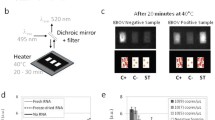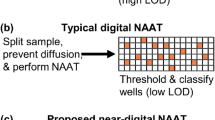Abstract
Loop-mediated isothermal amplification or LAMP has been identified to be an efficient technology for point-of-care diagnostics. Paper-based LAMP technique has tremendous potential in replacing the existing tube–based technology as the manufacturing cost of a paper-based device is comparatively lower and easy-to-use. LAMP-based paper diagnostic device for Mycobacterium tuberculosis (MTB) detection is of extreme importance as it will help in early and rapid diagnosis of the affected patients. The fabrication of these devices requires assessment of design parameters on the extent of LAMP amplification reaction. Hence, CFD studies would be extremely beneficial from the design perspective. The current work presents an insight into the CFD simulations for LAMP amplification reaction on a porous paper membrane (nitrocellulose membrane). The convection–diffusion–reaction model is solved on a COMSOL Multiphysics 5.0 platform. Studies on effect of pore size, aspect ratio and initial DNA concentration on the extent of DNA amplification reaction have been carried out. The current paper-based technique is effective in detecting a minimum of 5 copies of DNA contrasting the previous semi-quantitative technique which demonstrated the detection of minimum 98 copies. Overall, the simulation results displayed almost 96% enhancement in the DNA amplification rate on paper membrane.

Graphical abstract for the computational study of DNA amplification reaction via LAMP technique on a porous paper membrane.







Similar content being viewed by others
References
Majumder AK, Chowdhury SK (1981) Recording and preliminary analysis of respiratory sounds from tuberculosis patients. Med Biol Eng Comput 19(5):561–564
Aguiar FS, Torres RC, Pinto JV, Kritski AL, Seixas JM, Mello FC (2016) Development of two artificial neural network models to support the diagnosis of pulmonary tuberculosis in hospitalized patients in Rio de Janeiro, Brazil. Med Biol Eng Comput 54(11):1751–1759
Lewin A, Sharbati-Tehrani S (2005) Slow growth rate of mycobacteria. Possible reasons and significance for their pathogenicity. Bundesgesundheitsblatt Gesundheitsforschung, Gesundheitsschutz 48(12):1390–1399
Steingart KR, Henry M, Ng V, Hopewell PC, Ramsay A, Cunningham J, Pai M (2006) Fluorescence versus conventional sputum smear microscopy for tuberculosis: a systematic review. Lancet Infect Dis 6(9):570–581
Steingart KR, Henry M, Ng V, Hopewell PC, Ramsay A, Cunningham J, Pai M (2006) Sputum processing methods to improve the sensitivity of smear microscopy for tuberculosis: a systematic review. Lancet Infect Dis 6(10):664–674
Steingart KR, Ramsay A, Pai M (2007) Optimizing sputum smear microscopy for the diagnosis of pulmonary tuberculosis. Expert Rev Anti-Infect Ther 5(3):327–331
Barnhoorn F, Adriaanse H (1992) In search of factors responsible for non-compliance among tuberculosis patients in Wardha District, India. Soc Sci Med 34(3):291–306
Jo EK, Park JK, Dockrell HM (2003) Dynamics of cytokine generation in patients with active pulmonary tuberculosis. Curr Opin Infect Dis 16(3):205–210
Saybani MR, Shamshirband S, Golzari S, Wa TY, Saeed A, Kiah MLM, Balas VE (2016) RAIRS2 a new expert system for diagnosing tuberculosis with real-world tournament selection mechanism inside artificial immune recognition system. Medical & biological engineering & computing 54(2–3):385–399
Mullis KB (1987) U.S. Patent No. 4,683,202. Washington, DC: U.S. Patent and Trademark Office
Malek LT, Davey C, Henderson G, Sooknanan R (1992) U.S. Patent No. 5,130,238. Washington, DC: U.S. Patent and Trademark Office
Davey C, Malek LT (1995) U.S. Patent No. 5,409,818. Washington, DC: U.S. Patent and Trademark Office
Enzelberger MM, Liu J, Quake SR (2005) U.S. Patent No. 6,960,437. Washington, DC: U.S. Patent and Trademark Office
Schweitzer B, Kingsmore S (2001) Combining nucleic acid amplification and detection. Curr Opin Biotechnol 12(1):21–27
Notomi T, Okayama H, Masubuchi H, Yonekawa T, Watanabe K, Amino N, Hase T (2000) Loop-mediated isothermal amplification of DNA. Nucleic Acids Res 28(12):e63–e63
Parida M, Horioke K, Ishida H, Dash PK, Saxena P, Jana AM, Morita K (2005) Rapid detection and differentiation of dengue virus serotypes by a real-time reverse transcription-loop-mediated isothermal amplification assay. J Clin Microbiol 43(6):2895–2903
Yamazaki W, Ishibashi M, Kawahara R, Inoue K (2008) Development of a loop-mediated isothermal amplification assay for sensitive and rapid detection of Vibrio parahaemolyticus. BMC Microbiol 8(1):163
Njiru ZK, Mikosza ASJ, Armstrong T, Enyaru JC, Ndung'u JM, Thompson ARC (2008) Loop-mediated isothermal amplification (LAMP) method for rapid detection of Trypanosoma brucei rhodesiense. PLoS Negl Trop Dis 2(2):e147
Hopkins H, González IJ, Polley SD, Angutoko P, Ategeka J, Asiimwe C, Bell D (2013) Highly sensitive detection of malaria parasitemia in a malaria-endemic setting: performance of a new loop-mediated isothermal amplification kit in a remote clinic in Uganda. J Infect Dis 208(4):645–652
Zhu Q, Gao Y, Yu B, Ren H, Qiu L, Han S, Mu Y (2012) Self-priming compartmentalization digital LAMP for point-of-care. Lab Chip 12(22):4755–4763
Njiru ZK (2012) Loop-mediated isothermal amplification technology: towards point of care diagnostics. PLoS Negl Trop Dis 6(6):e1572
Hsiang MS, Greenhouse B, Rosenthal PJ (2014) Point of care testing for malaria using LAMP, loop mediated isothermal amplification. J Infect Dis 210:1167–1169
Rohrman BA, Richards-Kortum RR (2012) A paper and plastic device for performing recombinase polymerase amplification of HIV DNA. Lab Chip 12(17):3082–3088
Linnes JC, Fan A, Rodriguez NM, Lemieux B, Kong H, Klapperich CM (2014) Paper based molecular diagnostic for Chlamydia trachomatis. RSC Adv 4(80):42245–42251
Connelly JT, Rolland JP, Whitesides GM (2015) “Paper machine” for molecular diagnostics. Anal Chem 87(15):7595–7601
Hongwarittorrn I, Chaichanawongsaroj N, Laiwattanapaisal W (2017) Semi-quantitative visual detection of loop mediated isothermal amplification (LAMP)-generated DNA by distance-based measurement on a paper device. Talanta 175:135–142
Seok Y, Joung HA, Byun JY, Jeon HS, Shin SJ, Kim S, Shin YB, Han HS, Kim MG (2017) A paper-based device for performing loop-mediated isothermal amplification with real-time simultaneous detection of multiple DNA targets. Theranostics 7(8):2220
Aziz I, Jamshaid R, Zaidiand T, Akhtar I (2016) Numerical simulation of heat transfer to optimize DNA amplification in Polymerase Chain Reaction. 13th International Bhurban Conference on Applied Sciences and Technology (IBCAST) (p. 456-462). IEEE
Jamshaid R, Aziz I (2017) Numerical simulations to analyze the effect of various heater configurations on heat transfer in polymerase chain reaction devices. IEEE International Conference on Advanced Intelligent Mechatronics (AIM) (p. 1298-1303). IEEE
Kumar P, Pandya D, Singh N, Behera D, Aggarwal P, Singh S (2014) Loop-mediated isothermal amplification assay for rapid and sensitive diagnosis of tuberculosis. J Infect 69(6):607–615
Liu W, Peng Y, Yin Y, Zhou Z, Zhou W, Dai Y (2014) The involvement of NADPH oxidase-mediated ROS in cytokine secretion from macrophages induced by mycobacterium tuberculosis ESAT-6. Inflammation. 37:880–892
Boggaram V, Gottipati KR, Wang X, Samten B (2013) Early secreted antigenic target of 6 kda (ESAT-6) protein of Mycobacterium tuberculosis induces interleukin-8 (il-8) expression in lung epithelial cells via protein kinase signaling and reactive oxygen species. J Biol Chem 288:25500–25511
Li H, Han D, Hegener MA, Pauletti GM, Steckl AJ (2017) Flow reproducibility of whole blood and other bodily fluids in simplified no reaction lateral flow assay devices. Biomicrofluidics 11(2):024116
Tjaden B, Brett DJ, Shearing PR (2018) Tortuosity in electrochemical devices: a review of calculation approaches. Int Mater Rev 63(2):47–67
Bruggeman VD (1935) Berechnung verschiedener physikalischer Konstanten von heterogenen Substanzen. I Dielektrizitätskonstanten und Leitfähigkeiten der Mischkörper aus isotropen Substanzen Annalen der physik 416(7):636–664
Shrestha A (2012) Characterization of porous membranes via porometry
Van Brakel J, Heertjes PM (1974) Analysis of diffusion in macroporous media in terms of a porosity, a tortuosity and a constrictivity factor. Int J Heat Mass Transf 17(9):1093–1103
Liu C, Sadik MM, Mauk MG, Edelstein PH, Bushman FD, Gross R, Bau HH (2014) Nuclemeter: a reaction-diffusion based method for quantifying nucleic acids undergoing enzymatic amplification. Sci Rep 4:7335
Zolgharni M, Ledger PD, Griffiths H (2009) Forward modelling of magnetic induction tomography: a sensitivity study for detecting haemorrhagic cerebral stroke. Medical & biological engineering & computing 47(12):1301–1313
Grundl D, Zhang X, Messaoud S, Pfister C, Demmel F, Mommer MS, Wolf B, Brischwein M (2013) Reaction–diffusion modelling for microphysiometry on cellular specimens. Medical & biological engineering & computing 51(4):387–395
Soltani M, Rahpeima R, Kashkooli FM (2019) Breast cancer diagnosis with a microwave thermoacoustic imaging technique - a numerical approach. Medical & biological engineering & computing 57:1497–1513
Acknowledgments
The first author would like to thank the Department of Mechanical Engineering, IIT Kanpur for providing the necessary infrastructure.
Funding
This study is supported by the Department of Science and Technology, Government of India (vide grant no DST/INSPIRE/04/2018/001536) for providing the project grant.
Author information
Authors and Affiliations
Corresponding author
Ethics declarations
Conflict of interest
The authors declare that they have no conflict of interest.
Additional information
Publisher’s note
Springer Nature remains neutral with regard to jurisdictional claims in published maps and institutional affiliations.
Rights and permissions
About this article
Cite this article
Das, D., Panigrahi, P. CFD simulations for paper-based DNA amplification reaction (LAMP) of Mycobacterium tuberculosis—point-of-care diagnostic perspective. Med Biol Eng Comput 58, 271–289 (2020). https://doi.org/10.1007/s11517-019-02082-y
Received:
Accepted:
Published:
Issue Date:
DOI: https://doi.org/10.1007/s11517-019-02082-y




